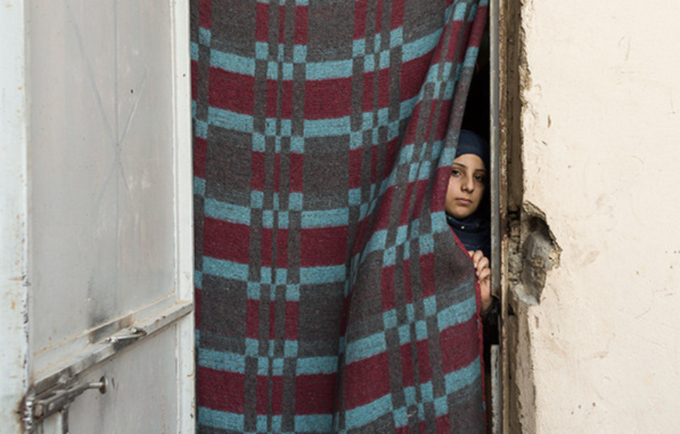“I don’t think the world understands what it means to be a woman living in Syria today,” says Shatha, a woman from Deir-ez-Zor, who is a survivor of gender-based violence.
Towards the end of 2023, Deir-ez-Zor became one of the hotspots of the worst intensification of conflict Syria has seen since 2019, leading to the displacement of over 120,000 individuals and severely impacting essential services like healthcare, education, and water supply. This surge in violence followed closely on the heels of a catastrophic earthquake in February, which brought widespread devastation to the north-west of the country, affecting almost 9 million people.

Thirteen years after the onset of the crisis in 2011, basic service capacity in Syria continues to erode. Despite the continuing efforts of humanitarian actors, the crisis remains one of the world’s most complex humanitarian and protection emergencies. In 2024, 16.7 million people are in need of humanitarian assistance — the highest number since 2011. This includes over 8 million women and girls, around 4.1 million of whom are of reproductive age. Meanwhile, more than 6.3 million Syrian refugees remain in five neighbouring countries – Türkiye, Lebanon, Jordan, Iraq and Egypt — nearly half of whom are women and girls who face mounting risks of violence, exploitation, and lack of access to essential services.
In addition to many women and girls lacking access to quality sexual and reproductive health services, gender-based violence continues to pervade the daily lives of the women and girls impacted by the crisis.

"Things have deteriorated significantly in recent years," shares Sali, a young resident of Areesha camp in Syria. Forced into child marriage at 14, shortly after the crisis began, she fortunately found support in a UNFPA-supported safe space that aided her in healing from her trauma. "This is a common story for many girls here, yet many do not have the opportunity to find the support that I did."
The experiences of women and girls like Sali are deeply affected by interlinked forms of violence and gender inequality, often intensified by discriminatory attitudes related to age, displacement status, disability, and marital status. Reports consistently highlight harassment, violence from intimate partners and family members, child and forced marriages leading to early pregnancies, as well as sexual violence and exploitation. Additionally, recent years have seen the proliferation of technology-facilitated gender-based violence as a growing concern.
Such conditions perpetuate a harmful environment where the health and wellbeing of women and girls are under constant threat, leading to their devaluation, manipulation, exploitation, and subsequent victim-blaming. Adolescent girls, in particular, encounter numerous obstacles that tend to follow them throughout their lives. These challenges often start with restricted freedom of movement and domestic violence, evolving into issues such as child and forced marriages, continuous domestic abuse, early pregnancies, sexual violence, and exploitation as they grow. Furthermore, the denial of educational opportunities further diminishes their prospects for the future, potentially locking them into a relentless cycle of violence and exploitation.
Similar challenges plague the lives of the more than 6.3 million Syrian refugees dispersed across neighbouring countries, where women and girls are particularly vulnerable. The ongoing crisis has heightened the risks of gender-based violence (GBV), with many refugees living in densely populated areas where harassment, assault, and exploitation loom as constant threats. The war's economic fallout, worsened by global events like the conflict in Ukraine, has driven families to resort to desperate measures for survival, such as child and forced marriages.
Additionally, Syrian refugees face numerous hurdles in their host countries, complicating their journey towards healing and rebuilding their lives. These hurdles range from language and cultural differences to discrimination, economic hardship, and barriers to accessing employment, education, healthcare, and vital services. For women and girls among the refugee population, these challenges not only heighten their vulnerability to violence and exploitation but also hinder their legal recourse and efforts towards social integration, leading to their marginalisation and exclusion from society.
Crucially, the deepening plight of Syrians serves as a stark warning amid the surge of armed conflicts and humanitarian emergencies worldwide. From the regional crises in Gaza, Sudan, Yemen, and Lebanon to the devastating, far-reaching conflict in Ukraine, each situation urgently calls for attention and substantial aid. This growing crisis landscape is stretching the already scarce humanitarian resources thin, causing the needs of Syria to be overshadowed and support for its most vulnerable citizens to dwindle.
The lack of funding for humanitarian efforts in Syria, especially those targeting services for women and girls, is having a tangible impact on many communities. Vital reproductive healthcare facilities, which offer life-saving services, are on the brink of closure. Furthermore, safe spaces for women and girls, which are essential for survivors of gender-based violence, are being shut down, leaving them without a place of refuge or support.
Despite these impossible odds, UNFPA is committed to meeting the staggering needs in 2024. Last year alone, as part of its regional response to the crisis, UNFPA provided sexual and reproductive health services to over 1.9 million people and supported more than 880,000 individuals with programmes aimed at preventing and addressing gender-based violence. Additionally, over 365,000 adolescent girls received essential services, while over 16,000 women benefited from cash and voucher assistance, and more than 10,000 LGBTQIA+ individuals received support.
To sustain its response over the coming year, UNFPA is appealing for $132.5 million, around $67.3 million of which will be allocated to programmes throughout Syria. We call on the global community to place people before politics and ensure that the humanitarian response is fully funded — not only to meet the urgent needs but also to invest in building a more resilient Syria.




